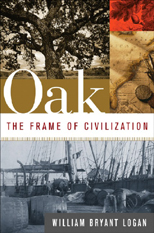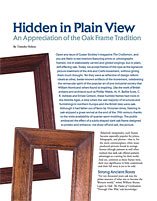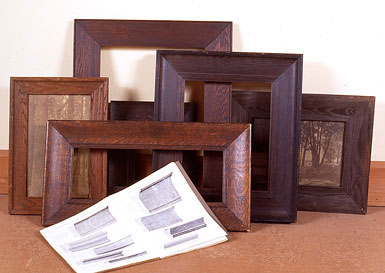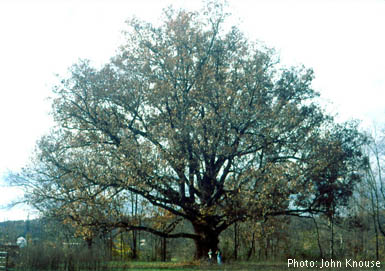Of all the woods available to us, quartersawn white oak has become our favorite, being not only extraordinarily well suited to a range of pictures, but a pleasure to work as well. Its greatest appeal, however, stems from the extremely deep-seated folk tradition associated with a wood archaelogists have established as truly one of the primary materials of civilization — or as one scholar has called it, “the frame of civilization.”
The British Arts and Crafts Movement emulated the spirit of the pre-industrial age, when the vast majority of furnishings were made of oak. As Gustav Stickley wrote,
“There is something about oak that stirs the imagination, [suggesting] the rich somber time-mellowed rooms of old English houses which have seen generation after generation live and die in them… In fact, oak has come to stand as a symbol of strength and permanence, and a great part of our affection for it comes from the romance and rare old associations with which its very name is surrounded.”

We recommend William Bryant Logan’s Oak: The Frame of Civilization. — a wonderfully readable appreciation of the tree, and its extraordinary significance in natural and human history.
Before industrialization, throughout the world’s temperate zone oak was the wood of choice for furnishings. Early Renaissance oak picture frames blended pictorial art effortlessly with oak paneling, cabinets and furniture. With a growing population and commercial industrialization, though, oak became not only scarce but less fashionable as well. By the late eighteenth century it was regarded by an increasingly urbane populace as hopelessly crude — a reminder of a backward age. Oak was scorned as a peasant wood.
But by the latter half of the nineteenth century a reaction was taking place: a broad-based revival of the arts, rooted in the period’s revolutionary social movements, sought to bring back the former integrity and dignity of the arts by returning them to a more humane and democratic basis of artistic production. To this revival, which would culminate in the Arts and Crafts Movement, the coarse, humble native wood appealed as the stuff of the old “honest” wood furnishings — hand-hewn, grounded in simplicity and utility, and born out of the native landscape.

Read Tim’s article on the oak frame tradition, in Style 1900 magazine, Winter 2008-09, here…
Reviving its use for picture frames expressed reform ideals about the place of art — that art, no matter how refined and extraordinary it was capable of being, had to be grounded in the ordinary and everyday; that it was rooted in folk spirit and humble materials of the native land. “What we want is a vernacular,” the great Arts and Crafts reformer Walter Crane said; while the prominent architect Phillip Webb defined art as “folk instinct bubbling up from deep natural wells.” No wood could better serve the reform cause than oak.
From an aesthetic standpoint in framing, the variegated grain of oak suits the irregularities of hand-made pictures. The coarse grain and often wild figure is in keeping with depictions of weathered old buildings and the untamed forms of trees and rocks which captivated 19th century Romanticism’s appreciation for nature and rural life unspoiled by industrialization.
But just as importantly it carries those “rare old associations” Stickley wrote about, rooted in an ancient and vital folk tradition — part of the extraordinary, primal human relationship to the oak tree.
To learn more about the profound significance of oak in the history of civilization, see William Bryant Logan’s Oak: The Frame of Civilization (W.W. Norton & Co., 2005).

Turn of the century oak frames, with period molding manufacturer’s catalog showing designs offered in quartersawn oak.
